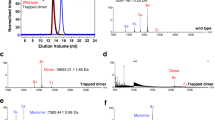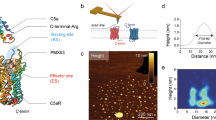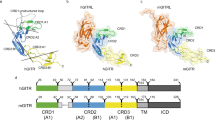Abstract
Granulocyte colony-stimulating factor (GCSF) is the principal growth factor regulating the maturation, proliferation and differentiation of the precursor cells of neutrophilic granulocytes1 and is used to treat neutropenia2. GCSF is a member of the long-chain subtype of the class 1 cytokine superfamily, which includes growth hormone, erythropoietin, interleukin 6 and oncostatin M (ref. 3). Here we have determined the crystal structure of GCSF complexed to the BN–BC domains, the principal ligand-binding region of the GCSF receptor (GCSFR). The two receptor domains form a complex in a 2:2 ratio with the ligand, with a non-crystallographic pseudo-twofold axis through primarily the interdomain region and secondarily the BC domain. This structural view of a gp130-type receptor–ligand complex presents a new molecular basis for cytokine–receptor recognition.
This is a preview of subscription content, access via your institution
Access options
Subscribe to this journal
Receive 51 print issues and online access
$199.00 per year
only $3.90 per issue
Buy this article
- Purchase on Springer Link
- Instant access to full article PDF
Prices may be subject to local taxes which are calculated during checkout



Similar content being viewed by others
References
Metcalf,D. The molecular control of cell division, differentiation commitment and maturation in haemopoietic cells. Nature 339, 27–30 (1989).
Welte,K. et al. Filgrastim (r-metHuG-CSF): the first 10 years. Blood 88, 1907–1929 (1996).
Wells,J. A. & de Vos,A. M. Hematopoietic receptor complexes. Annu. Rev. Biochem. 65, 609–634 (1996).
Fukunaga,R., Ishizaka-Ikeda,E., Pan, C.-X., Seto,Y. & Nagata,S. Functional domains of the granulocyte colony-stimulating factor receptor. EMBO J. 10, 2855–2865 (1991).
Hiraoka,O., Anaguchi,H. & Ota,Y. Formation of 1:1 complex of the cytokine receptor homologous region of granulocyte colony-stimulating factor receptor with ligand. Biosci. Biotechnol. Biochem. 59, 2351–2354 (1995).
Hiraoka,O., Anaguchi,H., Asakura,A. & Ota,Y. Requirement for the immunoglobulin-like domain of granulocyte colony-stimulating factor receptor in formation of a 2:1 receptor–ligand complex. J. Biol. Chem. 270, 25928–25934 (1995).
Horan,T. P. et al. Coexpression of G-CSF with an unglycosylated G-CSF receptor mutant results in secretion of a stable complex. Protein Express. Purific. 14, 45–53 (1998).
Hiraoka,O., Anaguchi,H. & Ota,Y. Evidence for the ligand-induced conversion from a dimer to a tetramer of the granulocyte colony-stimulating factor receptor. FEBS Lett. 356, 255–260 (1994).
Horan,T. P. et al. Dimerization of the extracellular domain of granulocyte-colony stimulating factor receptor by ligand binding: a monovalent ligand induces 2:2 complexes. Biochemistry 35, 4886–4896 (1996).
de Vos,A. M., Ultsch,M. & Kossiakoff,A. A. Human growth hormone and extracellular domain of its receptor: crystal structure of the complex. Science 255, 306–312 (1992).
Syed,R. S. et al. Efficiency of signaling through cytokine receptors depends critically on receptor orientation. Nature 395, 511–516 (1998).
Hill,C. P., Osslund,T. D. & Eisenberg,D. The structure of granulocyte-colony-stimulating factor and its relationship to other growth factors. Proc. Natl Acad. Sci. USA 90, 5167–5171 (1993).
Yamasaki,K., Naito,S., Anaguchi,H., Ohkubo,T. & Ota,Y. Solution structure of an extracellular domain containing the WSXWS motif of the granulocyte colony-stimulating factor receptor and its interaction with ligand. Nature Struct. Biol. 4, 498–504 (1997).
Bravo,J., Staunton,D., Heath,J. K. & Jones,E. Y. Crystal structure of a cytokine-binding region of gp130. EMBO J. 17, 1665–1674 (1998).
Hage,T., Sebald,W. & Reinemer,P. Crystal structure of the Interleukin-4/Receptor α chain complex reveals a mosaic binding interface. Cell 97, 271–281 (1999).
Reidhaar-Olson,J. F., De Souza-Hart,J. A. & Selick,H. E. Identification of residues critical to the activity of human granulocyte colony-stimulating factor. Biochemistry 35, 9034–9041 (1996).
Layton,J. E., Iaria,J., Smith,D. K. & Treutlein,H. R. Identification of a ligand-binding site on the granulocyte colony-stimulating factor receptor by molecular modeling and mutagenesis. J. Biol. Chem. 272, 29735–29741 (1997).
Clackson,T. & Wells,J. A. A hot spot of binding energy in a hormone–receptor interface. Science 267, 383–386 (1995).
Wells,J. A. Binding in the growth hormone receptor complex. Proc. Natl Acad. Sci. USA 93, 1–6 (1996).
Hendsch,Z. S. & Tidor,B. Do salt bridges stabilize proteins? A continuum electrostatic analysis. Protein Sci. 3, 211–226 (1994).
Braden,B. C. & Poljak,R. J. Structural features of the reactions between antibodies and protein antigens. FASEB J. 9, 9–16 (1995).
Covell,D. G. & Wallqvist,A. Analysis of protein–protein interactions and the effects of amino acid mutations on their energetics: the importance of water molecules in the binding epitope. J. Mol. Biol. 269, 281–297 (1997).
Kuga,T. et al. Japanese Patent Publication (Kokoku) 8317 Feb. 2 (1994).
Yamasaki,M., Konishi,N., Yamaguchi,K., Itoh,S. & Yokoo,Y. Purification and characterization of recombinant human granulocyte colony-stimulating factor (rhG-CSF) derivatives: KW-2228 and other derivatives. Biosci. Biotechnol. Biochem. 62, 1528–1534 (1998).
Livnah,O. et al. An antagonist peptide–EPO receptor complex suggests that receptor dimerization is not sufficient for activation. Nature Struct. Biol. 5, 993–1004 (1998).
Livnah,O. et al. Crystallographic evidence for preformed dimers of erythropoietin receptor before ligand activation. Science 283, 987–990 (1999).
Remy,I., Wilson,I. A. & Michnick,S. W. Erythropoietin receptor activation by a ligand-induced conformation change. Science 283, 990–993 (1999).
Otwinowski,Z. & Minor,W. Processing of X-ray diffraction data collected in oscillation mode. Methods Enzymol. 276, 307–326 (1997).
Collaborative Computational Project, Number 4. The CCP4 Suite: Programs for crystallography. Acta Crystallogr. D 50, 760–763 (1994).
Brünger,A. T. X-PLOR, Version 3.1, A System for X-ray Crystallography and NMR (Yale Univ. Press, New Haven, 1992).
Acknowledgements
We thank N. Kamiya and M. Kawamoto for their help in the use of the data collection facilities at SPring-8, Hyogo, Japan, and N. Sakabe and N. Watanabe for use of the facilities at Photon Factory, Tsukuba, Japan. We thank S. Nagata for providing the GCSFR cDNA, E. Yanagihara and N. Okitsu for assistance in sample preparation, and Y. Kato, D. Kohda, H. Toh, K. Yamasaki and S. Tsutakawa for useful discussions. This study was partly supported by a grant from TARA (Tsukuba Advanced Research Alliance), University of Tsukuba, Japan.
Author information
Authors and Affiliations
Corresponding author
Rights and permissions
About this article
Cite this article
Aritomi, M., Kunishima, N., Okamoto, T. et al. Atomic structure of the GCSF–receptor complex showing a new cytokine–receptor recognition scheme. Nature 401, 713–717 (1999). https://doi.org/10.1038/44394
Received:
Accepted:
Issue Date:
DOI: https://doi.org/10.1038/44394
This article is cited by
-
A topological refactoring design strategy yields highly stable granulopoietic proteins
Nature Communications (2022)
-
Purification and Characterization of DT389GCSF Fusion Protein: A Unique Immunotoxin Against the Human Granulocyte-Colony Stimulating Factor Receptor
International Journal of Peptide Research and Therapeutics (2020)
-
Characterization of Stress-Exposed Granulocyte Colony Stimulating Factor Using ELISA and Hydrogen/Deuterium Exchange Mass Spectrometry
Journal of the American Society for Mass Spectrometry (2014)
-
Establishing analytical comparability for “biosimilars”: filgrastim as a case study
Analytical and Bioanalytical Chemistry (2014)
-
Analytical techniques and bioactivity assays to compare the structure and function of filgrastim (granulocyte-colony stimulating factor) therapeutics from different manufacturers
Analytical and Bioanalytical Chemistry (2014)
Comments
By submitting a comment you agree to abide by our Terms and Community Guidelines. If you find something abusive or that does not comply with our terms or guidelines please flag it as inappropriate.



